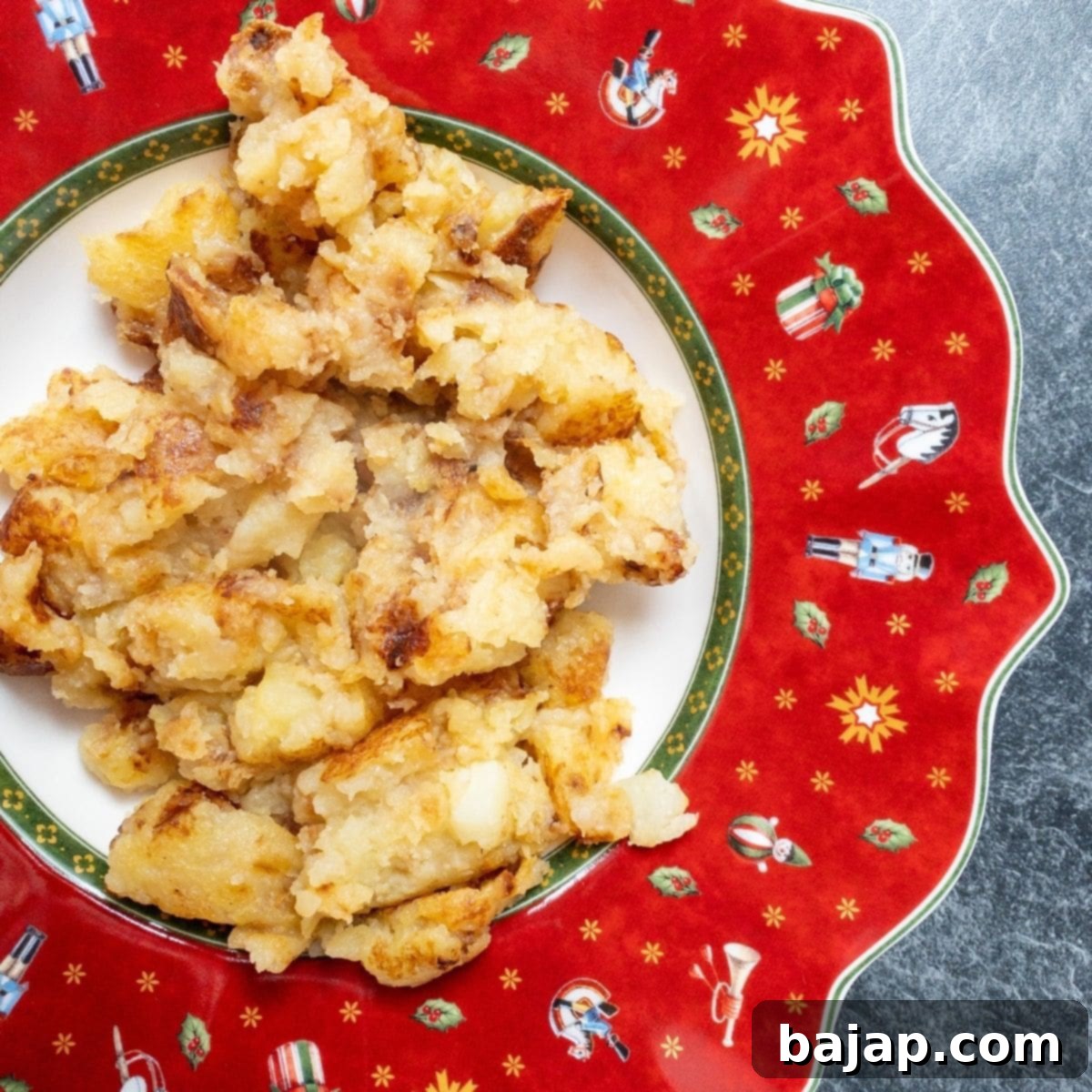Authentic Austrian Erdäpfelschmarrn: The Ultimate Pan-Fried Potato Recipe
Welcome to the heart of Austrian comfort food! Today, we’re diving into the delightful world of Erdäpfelschmarrn, a truly authentic Austrian potato side dish that captures the essence of home-cooked goodness. Traditionally, this flavorful dish is served alongside classics like Tafelspitz (prime boiled beef), the zesty Apfelkren (apple horseradish sauce), and fresh Chives Sauce. What makes Erdäpfelschmarrn a beloved staple isn’t just its rich taste, but also its simplicity and affordability. It’s quick to prepare, requires minimal ingredients, and delivers an incredibly satisfying flavor that appeals to everyone.
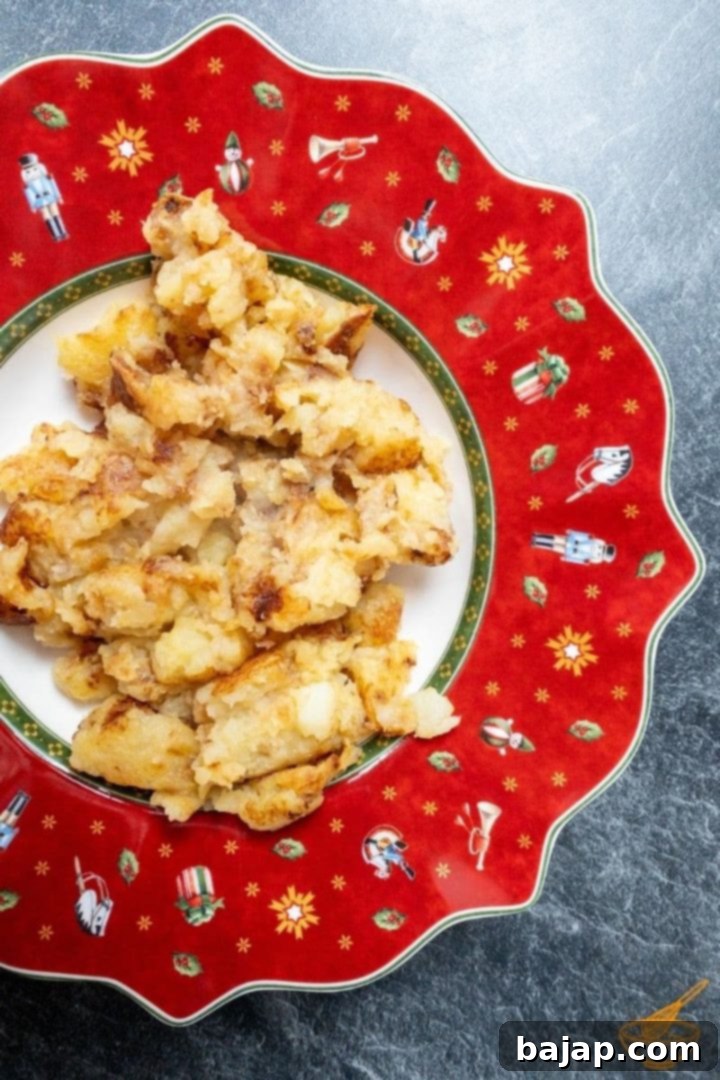
Before we dive into the recipe, let’s clear up a common linguistic quirk that often fascinates visitors to Austria. The word “Erdäpfel” is the uniquely Austrian term for potato, a charming local dialect that distinguishes it from the more widely used German “Kartoffel.” This distinction isn’t just a trivial detail; it’s a peek into Austria’s proud culinary and linguistic heritage. If you ever find yourself in a traditional Viennese restaurant, perhaps a renowned establishment like Plachutta, and wish to order a classic Tafelspitz with its accompanying potato dish, using “Erdäpfelschmarrn” will surely earn you a nod of appreciation from the locals.
Here in Austria, there’s a certain fondness and even a touch of stubbornness when it comes to preserving traditional language, especially in old-established, authentic restaurants. They love to emphasize these historical Austrian terms, which adds to the unique charm of the dining experience. It’s more than just a word; it’s a cultural statement.
This linguistic particularity extends beyond just potatoes. For instance, a pancake in Austria is called a “Palatschinke,” never a “Pfannkuchen.” Similarly, what Germans call “rote Beete” (beetroot) is always referred to as “rote Rüben” here. These subtle yet significant differences highlight the distinct identity of Austrian cuisine and culture. While I could list countless other examples of these delightful linguistic nuances, our focus today remains firmly on mastering the art of making the perfect Erdäpfelschmarrn. Get ready to create a dish that’s simple, satisfying, and authentically Austrian!
This dish is incredibly versatile, making it a perfect addition to a wide range of meals. Whether you’re planning a hearty Sunday roast or looking for a quick and comforting weeknight side, Erdäpfelschmarrn fits the bill. Its crispy texture and rich potato flavor make it a fantastic companion to meat dishes, but it’s equally delicious when paired with lighter fare. Plus, the minimal cost of ingredients means you can enjoy this gourmet-tasting dish without breaking the bank. It’s a true testament to the philosophy that some of the best food comes from simple, honest ingredients and time-honored techniques.
🥘 Ingredients
- 17.64 oz (750 g) raw Russet potatoes
- 1 teaspoon salt (for boiling + extra for seasoning)
- ½ Onion (yellow or white, depending on preference)
- 2-3 tablespoon Oil (Rapeseed or Olive Oil, for frying)
🍽 Equipment
- Frying Pan (a sturdy one or cast iron skillet works best for even browning)
- Cooking Pot (large enough to boil potatoes comfortably)
- Grater (box grater with large holes recommended)
- Wooden Spoon (for stirring and mixing)
- Kitchen Knife (sharp, for chopping)
- Cutting Board (stable surface for prep)
- Mixing Bowl (large, for grating and combining ingredients)
🔪 Instructions
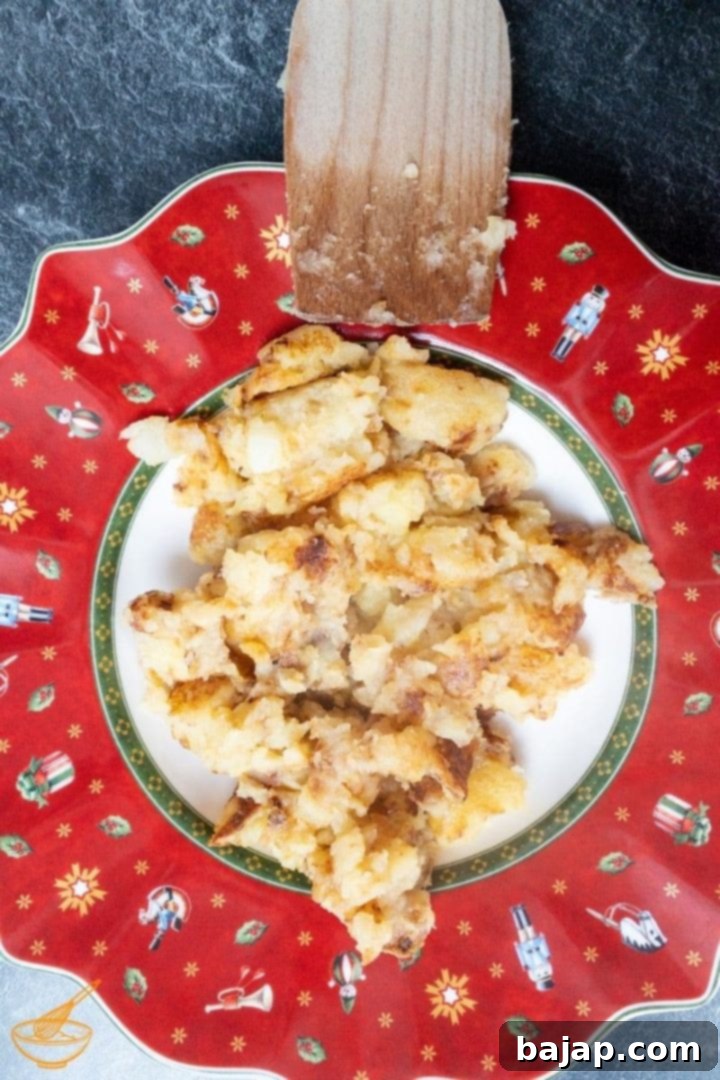
1. Boil the Potatoes: Begin by placing the unpeeled raw potatoes into a suitable cooking pot. Fill the pot with enough water to fully cover the potatoes. Add a generous teaspoon of salt to the water, which helps season the potatoes from the inside. Bring the water to a boil and cook the potatoes until they are firm to the bite – this means they should be tender when pierced with a fork, but not mushy. This usually takes between 20-30 minutes, depending on their size. Once cooked, carefully drain the water and let the potatoes cool slightly before handling. Be cautious, as they will still be very hot!
2. Peel and Grate: Once the potatoes are cool enough to handle, peel them carefully. The skins should slip off easily. Then, using a large grater (a box grater with large holes works wonderfully), grate all the boiled potatoes into a spacious mixing bowl. Aim for coarse, even strands, as this texture is key to the traditional Erdäpfelschmarrn.
3. Prepare the Onion: Take half of an onion (or a whole one, if you prefer a stronger onion flavor) and peel it. Finely chop the onion into small pieces. The size of the chop is important; you want them small enough to soften and caramelize nicely without overpowering the potato flavor.
4. Fry the Onion: Heat 2-3 tablespoons of oil (rapeseed or olive oil) in a large frying pan or cast-iron skillet over medium-high heat. Once the oil is hot, add the chopped onion and fry it gently until it turns translucent and slightly golden. This step builds a foundational flavor for the dish.
5. Combine and Season: Add the grated potatoes to the pan with the fried onions. Mix them thoroughly with a wooden spoon, ensuring the onions are evenly distributed throughout the potatoes. Season generously with salt at this stage. You can also add a pinch of black pepper if desired, but traditionally, salt is the main seasoning.
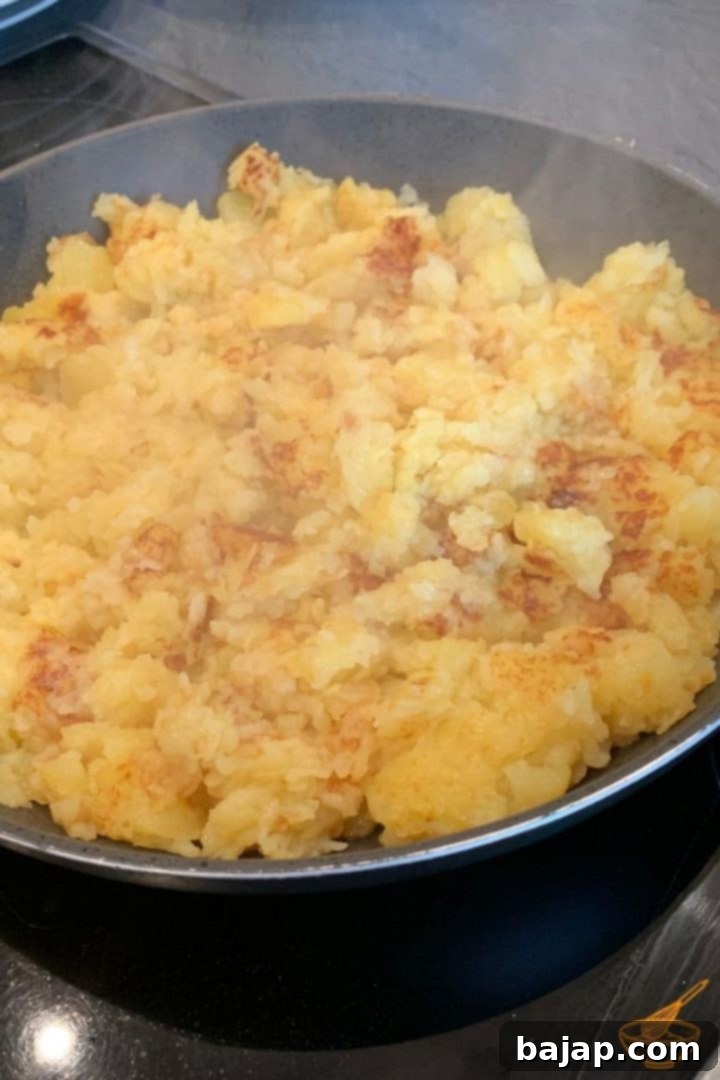
6. Achieve Golden Perfection: Spread the grated potato mixture evenly across the entire surface of the pan, forming a relatively flat layer. This is crucial for even browning. Now, here’s the golden rule for perfect Erdäpfelschmarrn: resist the urge to stir constantly! Let the potatoes fry undisturbed for several minutes until a beautiful, golden-brown crust forms on the bottom. Only then, carefully turn sections of the potatoes with your wooden spoon or spatula, breaking them into smaller, irregular pieces as you go. Continue this process, turning occasionally and allowing the potatoes to crisp up and brown on all sides. The goal is to evaporate any remaining moisture from the potatoes and achieve a wonderfully fried texture – crispy on the outside, tender on the inside. Be mindful not to let them burn, adjusting the heat as needed.
And voila! Your authentic Erdäpfelschmarrn is ready to be savored. This rustic, flavorful dish is truly exceptional when served with traditional Austrian accompaniments like Tafelspitz, refreshing apple horseradish sauce, and vibrant chive sauce. Beyond tradition, it also pairs delightfully with modern dishes, such as perfectly cooked air fryer asparagus. For an extra layer of texture and flavor, consider topping your Schmarrn with some homemade crispy onions without deep frying!
💭 Top Tips for Perfect Erdäpfelschmarrn
How to avoid soggy Erdäpfelschmarrn?
The secret to wonderfully crispy Erdäpfelschmarrn lies in managing moisture. Potatoes naturally contain a lot of water, and if this moisture isn’t properly evaporated during frying, you’ll end up with a disappointingly soft and unappealing dish. Here are the key points to ensure your potatoes are perfectly crisp:
- Hot Oil is Essential: Always ensure your oil is adequately hot before adding the grated potatoes to the pan. In our recipe, since you’re already frying the onions beforehand, the pan and oil will naturally be at a good temperature. However, if you opt to skip the onions due to dietary preferences or intolerances, make sure to preheat the oil thoroughly before introducing the grated potatoes. A sizzling pan means instant crisping.
- Evaporate Moisture: Once the potatoes are in the pan, resist the urge to stir them constantly. Instead, let them sit and brown. This allows the heat to work its magic, evaporating the potato’s internal moisture. You’ll notice steam rising from the pan – that’s the water escaping! Continue cooking and turning only occasionally until you no longer see significant steam and the potatoes start to feel lighter and distinctly crisper.
- Achieve Desired Browning: After the moisture has largely evaporated, focus on achieving that beautiful, golden-brown crust. This is where the flavor truly develops. The longer they brown (without burning!), the more intensely flavorful and delightfully crispy your Erdäpfelschmarrn will be.
Do I have to boil the potatoes first?
For this authentic Austrian Erdäpfelschmarrn recipe, the answer is a resounding yes. Boiling the potatoes first is a foundational step that ensures the final dish has the correct texture and prevents issues during frying. If you were to use raw grated potatoes for this dish, you would run the significant risk of the potatoes burning on the outside before the inside is fully cooked and tender. The pre-boiling process ensures the potatoes are cooked through, making them soft enough to grate easily and allowing them to crisp up beautifully in the pan without burning. While raw potatoes are excellent for dishes like hash browns, where a very firm and extra-crispy result is desired, for the traditional, rustic texture of Erdäpfelschmarrn, par-boiling is non-negotiable.
📖 Variations and Serving Suggestions
Erdäpfelschmarrn is wonderfully adaptable! While it traditionally accompanies boiled meat dishes, it can easily be transformed into a meat-free main course or a more elaborate side. For a delicious vegetarian option, serve it with creamy spinach and a perfectly fried egg on top. The runny yolk combined with the crispy potatoes is truly comforting. If you’re exploring other potato delights, you could also substitute Erdäpfelschmarrn with German Potato Pancakes (Kartoffelpuffer), which offer a similar, yet distinct, crispy potato experience.
Another fantastic savory variation, perfect for any time of year and especially satisfying for a casual meal, is to pair your Erdäpfelschmarrn with grilled knockwurst or other hearty sausages. The savory, slightly smoky flavor of the sausage complements the rich, crispy potatoes beautifully. You can also experiment with adding fresh herbs like parsley or chives directly into the grated potato mixture before frying for an extra layer of freshness. For a touch of spice, a pinch of paprika can be mixed in with the salt. Don’t be afraid to make it your own!
More potato recipes for you to try
- Duchess potatoes in the oven
- Duchess potatoes on the gas grill
- Potato flour cake with eggnog
- Stewed potatoes (by Moon and spoon and yum)
🇦🇹 You might also like
- How to make Apfelkren – Austrian Horseradish Sauce
- How to make delicious homemade Chive Sauce in 5 Minutes
- How to cook Tafelspitz (Austrian Prime Boiled Beef)
- Old-fashioned Whipping Cream Bundt Cake
📖 Recipe
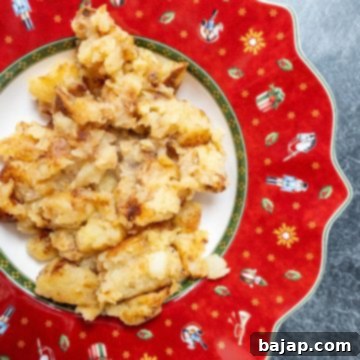
Grated Pan Fried Potatoes – Austrian Erdäpfelschmarrn
Nora
Save RecipeSaved!
Pin Recipe
Equipment
-
Frying Pan
-
Cooking Pot
-
Grater
-
Mixing bowl
-
Kitchen knife
-
Cutting Board
Ingredients
- 750 g Russet Potatoes
- 1 teaspoon Salt
- ½ Onion
- 2-3 tablespoon Rapeseed Oil or Olive Oil
Instructions
-
Put the unpeeled raw potatoes in a suitable cooking pot and fill it with water. Add a teaspoon of salt and boil the potatoes 20-30 minutes until they are firm to the bite.
-
Strain the potatoes and peel them (be careful hot!).
-
Grate the potatoes into a large mixing bowl.
-
Peel half the onion (you can use the whole one, depending on your preferences) and chop it.
-
Add 2-3 tablespoons of oil to a frying pan and fry the onion a little.
-
Add the grated potatoes and mix well with the onions and season with salt.
-
Spread the grated potatoes evenly across the pan and let them turn brown. It is important here not to stir constantly but only turn the potatoes from time to time. Continue until the potatoes no longer let water and are well fried.
Nutrition values are estimates only, using online calculators. Please verify using your own data.

⛑️ Food Safety
Ensuring food safety is paramount when preparing any meal. Follow these guidelines to keep your kitchen and food safe:
- Cook all food to a minimum internal temperature of 165 °F (74 °C) to eliminate harmful bacteria. While this recipe is vegetarian, this is a general rule for dishes containing meat or eggs.
- Always use separate utensils, cutting boards, and plates for raw meat (if you’re preparing a meat accompaniment) and cooked food to prevent cross-contamination.
- Thoroughly wash your hands with soap and warm water before and after handling any food, especially raw ingredients.
- Do not leave cooked food sitting out at room temperature for extended periods. Refrigerate leftovers promptly within two hours of cooking.
- Never leave cooking food unattended on the stovetop or in the oven. Always be present to monitor the cooking process.
- When frying, use oils with a high smoking point (like rapeseed oil or olive oil mentioned in the recipe) to avoid the formation of harmful compounds and off-flavors.
- Always ensure good ventilation in your kitchen, especially when using a gas stove, to prevent the buildup of fumes.
For further comprehensive information on safe food handling practices, please refer to reliable sources such as Safe Food Handling – FDA.
